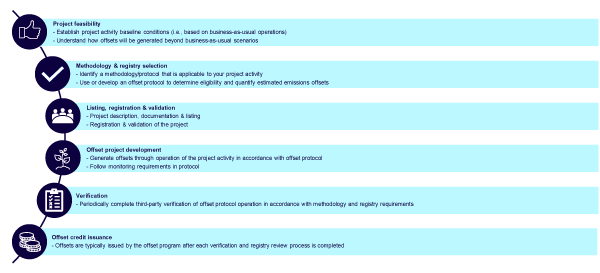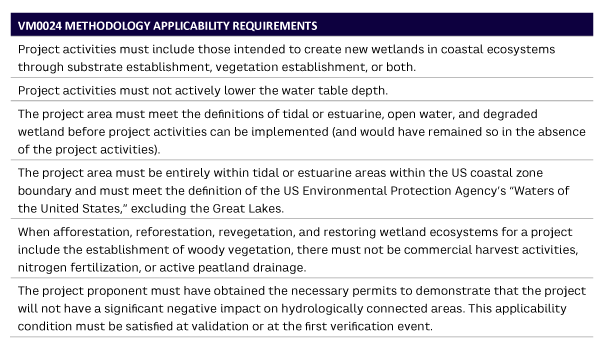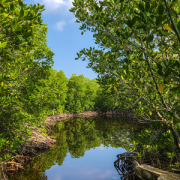In general, a carbon offset refers to the reduction or removal of carbon dioxide (CO2) or other greenhouse gas (GHG) from the atmosphere that mitigates emissions produced elsewhere (measured in CO2 equivalent, or CO2e).
Carbon-offset projects can range from renewable energy projects, energy efficiency, and forestry (afforestation, reforestation, or avoided deforestation) to methane capture/avoidance and waste management. Surrounding this concept are a multitude of protocols, methodologies, standards, and registries that evaluate, track, and monitor the progress of projects developed specifically for this purpose.
The term “blue carbon” is used to describe carbon stored in marine and coastal ecosystems, including seagrass meadows, salt marshes, tidal marshes, and mangroves that can sequester and store more carbon per unit area than terrestrial forests, establishing them as significant carbon sinks.
Although coastal wetlands cover less than 2% of the total ocean area, they account for approximately 50% of all carbon stored within ocean sediments. Consistent efforts are needed to ensure that such ecosystems are neither degraded nor damaged. This would result in the loss of their carbon-sink capacity, resulting in the release of large quantities of CO2 into the atmosphere. Projects to conserve, manage, and/or restore coastal ecosystems are essential to preventing this.
Blue carbon activities are one type of nature-based solution that have the potential to achieve most of the emission-reduction targets to keep warming levels below two degrees. Unfortunately, they lack sufficient funding, receiving only 3% of total global climate investments. For this reason, project proponents with coastal access are an essential part of developing this offset type and protecting these areas.
To develop a carbon-offset project, proponents undertake a series of assessments to determine viability of the project and calculate carbon-offset potential. Figure 1 shows the steps involved in establishing an offset project and the processes required before offsets can be generated and claimed under a project registry.

Proponents first determine whether the project area and activities will meet the criteria of the project methodology; then a baseline scenario is developed. The baseline scenario reflects the activities, GHG emissions, and sequestration that would occur at the project site should no project activities take place.
Next, proponents map out the project activities and the respective carbon reductions that would be achieved by the project. Proponents then develop the project scenario in line with a selected methodology to ensure that project outcomes do not vary excessively from the feasibility phase to the implementation phase.
Similar projects were identified that have used or propose to use the selected methodologies and were assessed for their relative carbon-sequestration potential and costs. Specifically, an in-development project registered with VCS as Bonos del Jaguar Azul (also within the Gulf of Mexico, in Yucatán, Mexico) showed the potential for success.
The Bonos del Jaguar Azul project showed emissions reductions of 48,250 tCO2e (tonnes of CO2 equivalent) for 2020. The estimated annual emissions reductions by 2046 (end of the project life) will be 158,986 tCO2e. The difference in values is due to the rate of biomass generation, in which plant growth continues to increase the carbon-sequestration potential. Table 1 shows the applicability to this type of project for the Gulf Coast.

In addition to meeting the methodology applicability requirements, a carbon project must satisfy an additionality requirement to ensure that the project would not have occurred in the absence of carbon market incentives or as part of business-as-usual activities. For the purposes of the project options, the additionality is assessed on whether project activities are mandated by law, statute, or another regulatory framework.
[For more from the author on this topic, see: “Nature-Based Solutions to Build Coastal Resilience.”]



